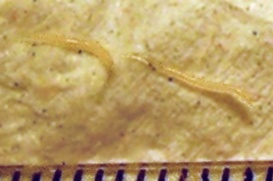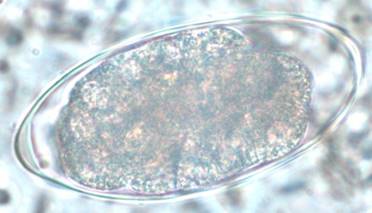|
Secernentea
Secernentea was a class of nematodes in the Classical Phylogeny System (Chitwood, 1958) and is no longer in use. This morphological-based classification system has been replaced by the Modern Phylogeny system, where taxonomy assignment is based on small subunit ribosomal DNA (SSU rDNA). Characteristics of Secernentea are: * Amphid apertures are pore/slit-like * Derids are present in some; located near nerve ring * Phasmids are present; posterior * Excretory system is tubular * Cuticle is striated in two to four layers; lateral field is present * Three esophageal glands; esophageal structure varies * Males generally have one testis * Caudal alae are common * Sensory papillae are cephalic only; may be caudal papillae in males * Mostly terrestrial * Rarely found in fresh or marine water Systematics Subclasses and orders of Secernentea are:Tree of Life Web Project (ToL) (2002)Nematoda. Version of January 1, 2002. Retrieved November 2, 2008. * Subclass Rhabditia (paraphyletic?) ... [...More Info...] [...Related Items...] OR: [Wikipedia] [Google] [Baidu] |
Secernentea
Secernentea was a class of nematodes in the Classical Phylogeny System (Chitwood, 1958) and is no longer in use. This morphological-based classification system has been replaced by the Modern Phylogeny system, where taxonomy assignment is based on small subunit ribosomal DNA (SSU rDNA). Characteristics of Secernentea are: * Amphid apertures are pore/slit-like * Derids are present in some; located near nerve ring * Phasmids are present; posterior * Excretory system is tubular * Cuticle is striated in two to four layers; lateral field is present * Three esophageal glands; esophageal structure varies * Males generally have one testis * Caudal alae are common * Sensory papillae are cephalic only; may be caudal papillae in males * Mostly terrestrial * Rarely found in fresh or marine water Systematics Subclasses and orders of Secernentea are:Tree of Life Web Project (ToL) (2002)Nematoda. Version of January 1, 2002. Retrieved November 2, 2008. * Subclass Rhabditia (paraphyletic?) ... [...More Info...] [...Related Items...] OR: [Wikipedia] [Google] [Baidu] |
Oxyurida
Oxyurida is an order of nematode worms of the class Secernentea. It consists of four families, one of which contains the human pinworm (''Enterobius vermicularis''). Species Notable species include: * ''Enterobius vermicularis'', the human pinworm * '' Gyrinicola batrachiensis'', a parasite or mutualist of amphibian tadpoles * ''Syphacia oryzomyos'', a parasite of the marsh rice rat (''Oryzomys palustris'') * '' Skrjabinema ovis'', a parasite of ruminant Ruminants (suborder Ruminantia) are hoofed herbivorous grazing or browsing mammals that are able to acquire nutrients from plant-based food by fermenting it in a specialized stomach prior to digestion, principally through microbial actions. The ...s References Parasitic nematodes of vertebrates Nematode orders {{parasitic animal-stub ... [...More Info...] [...Related Items...] OR: [Wikipedia] [Google] [Baidu] |
Diplogasteria
Diplogasterida was an order of nematodes. It was sometimes placed in a monotypic subclass Diplogasteria, but molecular phylogenetic evidence has shown it to be embedded in the family Rhabditidae (formerly Rhabditina). The confusion of having a hierarchical nesting of groups that were formerly mutually exclusive has led to a profusion of names. Although completely revised taxonomy of nematodes that builds on recent classification systems as well as recent phylogenetic evidence is still necessary, most contemporary taxonomic studies now treat all groups listed under "Diplogasterina" below as a single family, Diplogastridae. Subdivisions *Suborder Chambersiellina Hodda 2007 **Superfamily Chambersielloidea Thorne 1937 ***Family Chambersiellidae Thorne 1937 (Sanwal 1957) *Suborder Diplogasterina Paramonov 1952 **Superfamily Cylindrocorporoidea T. Goodey 1939 ***Family Cylindrocorporidae T. Goodey 1939 ***Family Odontopharyngidae Micoletzky 1922 **Superfamily Diplogasteroid ... [...More Info...] [...Related Items...] OR: [Wikipedia] [Google] [Baidu] |
Diplogasterida
Diplogasterida was an order of nematodes. It was sometimes placed in a monotypic subclass Diplogasteria, but molecular phylogenetic evidence has shown it to be embedded in the family Rhabditidae (formerly Rhabditina). The confusion of having a hierarchical nesting of groups that were formerly mutually exclusive has led to a profusion of names. Although completely revised taxonomy of nematodes that builds on recent classification systems as well as recent phylogenetic evidence is still necessary, most contemporary taxonomic studies now treat all groups listed under "Diplogasterina" below as a single family, Diplogastridae. Subdivisions *Suborder Chambersiellina Hodda 2007 **Superfamily Chambersielloidea Thorne 1937 ***Family Chambersiellidae Thorne 1937 (Sanwal 1957) *Suborder Diplogasterina Paramonov 1952 **Superfamily Cylindrocorporoidea T. Goodey 1939 ***Family Cylindrocorporidae T. Goodey 1939 ***Family Odontopharyngidae Micoletzky 1922 **Superfamily Diplogasteroidea M ... [...More Info...] [...Related Items...] OR: [Wikipedia] [Google] [Baidu] |
Ascaridida
The order Ascaridida includes several families of parasitic roundworms with three "lips" on the anterior end. They were formerly placed in the subclass Rhabditia by some, but morphological and DNA sequence data rather unequivocally assign them to the Spiruria. The Oxyurida and Rhigonematida are occasionally placed in the Ascaridida as superfamily Oxyuroidea, but while they seem indeed to be Spiruria, they are not as close to ''Ascaris'' as such a treatment would place them.Tree of Life Web Project (ToL) (2002)Nematoda Version of 2002-JAN-01. Retrieved 2008-NOV-02. These "worms" contain a number of important parasites of humans and domestic animals. Important families include: * The Anisakidae are also called the "marine mammal ascarids". The larvae of these worms cause anisakiasis when ingested by humans in raw or insufficiently cooked fish, but do not reproduce in humans. * The Ascarididae include the giant intestinal roundworms (''Ascaris'' spp.). * The Cosmocercidae include ... [...More Info...] [...Related Items...] OR: [Wikipedia] [Google] [Baidu] |
Aphelenchida
Aphelenchida is a moderately large order of nematodes. Aphelenchida have a stylet for feeding and a very prominent median bulb in the oesophagus. They are cosmopolitan. Some are associated with insects, and may be ectoparasites or endoparasites, or merely use the insect as transport. Others are associated with plants, as root, stem, or leaf parasites, which may be pathogenic to the plant or not. Still others are associated with fungi, and some are free-living. There may be considerable plasticity of feeding habits within species, involving almost any combination of the categories listed above. Sometimes different feeding habits involve morphologically distinct phases, but they may involve only behavioral differences, and sometimes depend only on the immediate availability of different foods. Some life cycle Life cycle, life-cycle, or lifecycle may refer to: Science and academia *Biological life cycle, the sequence of life stages that an organism undergoes from birth to rep ... [...More Info...] [...Related Items...] OR: [Wikipedia] [Google] [Baidu] |
Spirurida
Spirurida is an order of spirurian nematodes. Like all nematodes, they have neither a circulatory nor a respiratory system. Some Spirurida, like the genus ''Gongylonema'', can cause disease in humans. One such disease is a skin infection with Spirurida larvae, called "creeping disease". Some species are known as eyeworms and infect the orbital cavity of animal hosts. Systematics The Camallanida are sometimes included herein as a suborder, and the Drilonematida are sometimes placed here as a superfamily. There are doubts about the internal systematics of the Spirurida, and some groups placed herein might belong to other spirurian or even secernentean lineages.ToL (2002) The following superfamilies are at least provisionally placed in the Spirurida: * Acuarioidea * Aproctoidea * Diplotriaenoidea * Filarioidea * Gnathostomatoidea * Habronematoidea * Physalopteroidea * Rictularioidea * Spiruroidea * Thelazioidea Thelazioidea is a superfamily of spirurian nematodes in th ... [...More Info...] [...Related Items...] OR: [Wikipedia] [Google] [Baidu] |
Camallanida
The Camallanida are an order of nematodes. * Parasites of terrestrial and aquatic vertebrates * Copepods as obligatory secondary hosts They are sometimes included in the Spirurida as a suborder Camallanina. Notable species and genera *''Dracunculus medinensis ''Dracunculus medinensis'', or Guinea worm, is a nematode that causes dracunculiasis, also known as guinea worm disease. The disease is caused by the female which, at up to in length, is among the longest nematodes infecting humans. In contr ...'' (human as final host) and '' Anguillicola crassus'' (eels as final host) are important species. *'' Philometra'' is a genus in the family Philometridae that parasitises fish. References * Nematode orders {{Secernentea-stub ... [...More Info...] [...Related Items...] OR: [Wikipedia] [Google] [Baidu] |
Spiruria
Subclass Spiruria comprises mostly parasitic secernentean nematodes. In an alternate classification, they are treated as suborder Spirurina, with the orders listed here being ranked as infraorders. The Ascaridida and the Oxyurida, which include worms that infect many mammals (including marine mammals), are sometimes placed in subclass Rhabditia. But that seems as spurious as the erstwhile placement of the Rhigonematida in subclass Tylenchia. The Camallanida and Drilonematida are sometimes included in the Spirurida as suborder and superfamily, respectively.ToL (2002) Some important species *Giant roundworm (''Ascaris lumbricoides''), causes ascariasis in humans *''Toxocara canis'', parasite of dogs *''Anisakis'', responsible for the human disease Anisakiasis ''Anisakis'' (a·nuh·saa·keez) is a genus of parasitic nematodes that have life cycles involving fish and marine mammals. They are infective to humans and cause anisakiasis. People who produce immunoglobulin E in ... [...More Info...] [...Related Items...] OR: [Wikipedia] [Google] [Baidu] |
Rhabditida
Rhabditida is an order of free-living, zooparasitic, and phytoparasitic microbivorous nematodes living in soil. The Cephalobidae, Panagrolaimidae, Steinernematidae, and Strongyloididae seem to be closer to the Tylenchia, regardless of whether these are merged with the Rhabditia or not.Tree of Life Web Project (2002b)Nematoda Version of 2002-JAN-01. Retrieved 2008-NOV-02. Families Rhabditida * Myolaimina **''Incertae sedis'' *** Myolaimoidea ****Myolaimidae *Rhabditina ** Bunonematomorpha *** Bunonematoidea ****Bunonematidae ** Diplogasteromorpha *** Cylindrocorporoidea ****Cylindrocorporidae *** Diplogasteroidea **** Cephalobiidae ****Diplogasteridae ****Diplogasteroididae ** Rhabditomorpha *** Mesorhabditoidea ****Peloderidae *** Rhabditoidea ****Rhabditidae * Spirurina ** Ascaridomorpha *** Ascaridoidea **** Acanthocheilidae ****Anisakidae ****Ascarididae ****Heterocheilidae **** Raphidascarididae *** Cosmocercoidea ****Atractidae ****Kathlaniidae *** Seuratoidea **** Cuc ... [...More Info...] [...Related Items...] OR: [Wikipedia] [Google] [Baidu] |
Strongylida
The Strongylida suborder includes many of the important nematodes found in the gastrointestinal tracts of ruminants, horses, and swine, as well as the lungworms of ruminants and the hookworms of dogs and cats. Taxonomy This suborder includes (superfamily - included families): *Ancylostomatoidea ** Ancylostomatidae * Diaphanocephaloidea **Diaphanocephalidae * Heligmosomoidea ** Heligmosomidae * Metastrongyloidea **Angiostrongylidae **Crenosomatidae **Filaroididae **Metastrongylidae **Protostrongylidae **Pseudaliidae ** Syngamidae * Molineoidea ** Molineidae * Strongyloidea **Chabertiidae **Cloacinidae ** Deletrocephalidae ** Stephanuridae **Strongylidae *Trichostrongyloidea ** Amidostomatidae **Cooperiidae ** Dictyocaulidae ** Dromaeostrongylidae ** Haemonchidae ** Heligmonellidae **Heligmosomatidae ** Herpetostrongylidae ** Mackerrasrtongylidae ** Nicollinidae **Trichostrongylidae Major superfamilies Diaphanocephaloidea These are parasites of the digestive tracts of terrestr ... [...More Info...] [...Related Items...] OR: [Wikipedia] [Google] [Baidu] |
Tree Of Life Web Project
The Tree of Life Web Project is an Internet project providing information about the diversity and phylogeny of life on Earth. This collaborative peer reviewed project began in 1995, and is written by biologists from around the world. The site has not been updated since 2011, however the pages are still accessible. The pages are linked hierarchically, in the form of the branching evolutionary tree of life, organized cladistically. Each page contains information about one particular group of organisms and is organized according to a branched tree-like form, thus showing hypothetical relationships between different groups of organisms. In 2009 the project ran into funding problems from the University of Arizona. Pages and Treehouses submitted took a considerably longer time to be approved as they were being reviewed by a small group of volunteers, and apparently, around 2011, all activities ended. History The idea of this project started in the late 1980s. David Maddison was wor ... [...More Info...] [...Related Items...] OR: [Wikipedia] [Google] [Baidu] |

